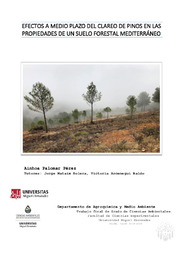Por favor, use este identificador para citar o enlazar este ítem:
https://hdl.handle.net/11000/27187Registro completo de metadatos
| Campo DC | Valor | Lengua/Idioma |
|---|---|---|
| dc.contributor.advisor | Mataix Solera, Jorge | - |
| dc.contributor.advisor | Arcenegui Baldó, Victoria | - |
| dc.contributor.author | Palomar Pérez, Ainhoa | - |
| dc.contributor.other | Departamentos de la UMH::Agroquímica y Medio Ambiente | es_ES |
| dc.date.accessioned | 2022-05-18T09:38:48Z | - |
| dc.date.available | 2022-05-18T09:38:48Z | - |
| dc.date.created | 2020-09-16 | - |
| dc.identifier.uri | http://hdl.handle.net/11000/27187 | - |
| dc.description.abstract | Una de las prácticas más comunes realizadas en la selvicultura preventiva de incendios son los clareos (reducción de la densidad de árboles por hectárea). Existen muchos estudios sobre la respuesta en la vegetación tras la realización de estos tratamientos, pero poco se conoce sobre la respuesta en las propiedades del suelo a medio plazo, con el fin de determinar si este tratamiento tiene un impacto en el mismo. En este trabajo se ha muestra la evolución temporal durante 2 años de la respiración edáfica basal (REB), el carbono de la biomasa microbiana (Cmic), el contenido de materia orgánica (MO), nitrógeno (N), fósforo asimilable (P) y la estabilidad de agregados (EA), en pinar afectado por un incendio en 1994 y cuya regeneración produjo una densidad muy alta de pinos. En 2017 es sometido a un tratamiento de clareo. Tras dos años de seguimiento, los cambios observados sobre las propiedades del suelo no son significativos a excepción de la biomasa microbiana, siendo esta algo más elevada en la zona tratada con clareo. Consideramos que sería interesante seguir con el estudio algunos años más con el fin de verificar esta tendencia y realizar un estudio sobre el efecto en la biodiversidad vegetal y la diversidad microbiana edáfica. | es_ES |
| dc.description.abstract | One of the most common practices carried out in fire preventive forestry is the clear-cutting (reduction of the density of trees per hectare). There are many studies on the response in the vegetation after carrying out these treatments, but little is known about the response in the properties of the soil in the medium term, in order to determine if this treatment has an impact on it. This work has shown the temporal evolution during 2 years of basal soil respiration (REB), microbial biomass carbon (Cmic), organic matter content (OM), nitrogen (N), available phosphorus (P) and aggregate stability (EA), in a pine forest affected by a fire in 1994 and whose regeneration produced a very high density of pines. In 2017 it is carried out a clear-cutting treatment. After two years of follow-up, the changes observed on the properties of the soil are not significant except for the microbial biomass, which is somewhat higher in the area treated with clear-cutting. We consider that it would be interesting to continue with the study for a few more years in order to verify this trend and carry out a study on the effect on plant biodiversity and soil microbial diversity. | es_ES |
| dc.format | application/pdf | es_ES |
| dc.format.extent | 35 | es_ES |
| dc.language.iso | spa | es_ES |
| dc.publisher | Universidad Miguel de Hernández de Elche | es_ES |
| dc.rights | info:eu-repo/semantics/openAccess | es_ES |
| dc.rights.uri | http://creativecommons.org/licenses/by-nc-nd/4.0/ | * |
| dc.subject | clareo | es_ES |
| dc.subject | suelo quemado | es_ES |
| dc.subject | pinar Mediterráneo | es_ES |
| dc.subject | selvicultura preventiva | es_ES |
| dc.subject.other | CDU::5 - Ciencias puras y naturales::50 - Generalidades sobre las ciencias puras::504 - Ciencias del medio ambiente | es_ES |
| dc.title | Efectos a medio plazo del clareo de pinos en las propiedades de un suelo forestal mediterráneo | es_ES |
| dc.type | info:eu-repo/semantics/bachelorThesis | es_ES |

Ver/Abrir:
TFG AINHOA PALOMAR_2020.pdf
1,43 MB
Adobe PDF
Compartir:
 La licencia se describe como: Atribución-NonComercial-NoDerivada 4.0 Internacional.
La licencia se describe como: Atribución-NonComercial-NoDerivada 4.0 Internacional.
.png)